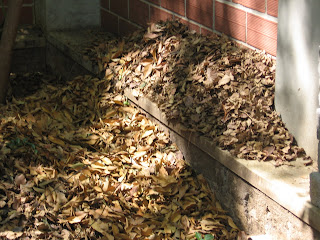My interest has been primarily due to the great productivity people have realized with Amrit Mitti plus the very low watering requirements that have been claimed. All this would integrate well with the long term low external input sustainable gardening philosophy which I am a big fan of. Otherwise city gardeners again become consumers (of red soil, compost, water etc.
which have to come from a distance and deplete their sources elsewhere!).
My friend Amarnath’s place (where we had earlier tried out the children’s community farm experiment - read about it here) was a godsend as there was space and most important the vital ingredients cow dung, urine as well as dry leaves. He was also equally keen on seeing how Amrit Mitti is different from the naturally composted cowdung.

Finally the whole process started off last Wednesday (March 9th) with Amrit Jal concentrate preparation (mixing cowdung, urine, jaggery and water and fermenting for three days). Our aim was to prepare a bed of 6ft x 3ftx 1ft. This would approximately translate to about 500 litres of volume. Hence we planned to prepare Amrit Jal of 500 litres. For the initial phase (concentrate) we need a drum of 50 litres capacity and this could be managed.

By Saturday Amrit Jal concentrate was ready. Now was the time to dilute it by 10 times. The challenge was to find a container of suitable capacity to hold the Amrit Jal in which the biomass would be soaked for 24 hours. Amar managed a metal drum of about 250 litres .


We had to collect some more dry leaves from his front yard as well as outside his compound. I supplemented this with a couple of bags of sugarcane bagasse and musambi peels (both from juice vendors). While sugarcane bagasse is a preferred material in Amrit Mitti, musambi peels has been my own addition on an experimental basis. It took the two of us roughly four hours (with breaks and a relaxed working) to complete the exercise.
Now that the major stages are over one activity which is left is the weekly exercise of tilling / mix up the Amrit Mitti bed which will be repeate for 3 weeks. Post that we will see if we should continue with the recommended 100 day cycle or start using the Amrit Mitti… Wait and watch for more details!
